Here’s a million-dollar question that keeps founders and growth leaders up at night: Why are some companies with a clear B2B Ideal Customer Profile hitting their revenue targets, while others burn through marketing budgets like kindling?
The answer isn’t sexy algorithms or viral TikTok strategies. It’s something far more fundamental (and, frankly, far more boring). Companies that consistently crush their growth targets have one thing in common: they know exactly who their ideal customer is.
I’m talking about having a B2B ideal customer profile so laser-focused that your sales team can spot a perfect fit customer from across a crowded trade show. And here’s the kicker: research shows that companies with a well-defined ICP close deals 68% faster than those still playing the “spray and pray” game.
However, many people make a crucial mistake in this process: they believe creating an ideal customer profile is simply about compiling basic demographics and calling it a day. That’s like trying to assemble IKEA furniture without the instructions; you might end up with something that resembles a chair, but it’s unlikely to be functional.
By understanding and avoiding these common missteps, you can feel enlightened and confident in your B2B ICP creation process.
What New Leaders Get Wrong About Customer Targeting
A typical early mistake for new growth leaders is assuming that a broad audience translates to better results. Picture a B2B SaaS company eager to grow. Their initial targeting strategy? “Small to medium businesses that need our software.”
On paper, it sounds logical. In reality, it’s a recipe for waste. After months of advertising to everyone from mom-and-pop pizza shops to venture-backed startups, the results are predictable: low conversion rates and marketing dollars spread too thin.
The problem is simple: when you’re speaking to everyone, you’re resonating with no one. The real growth inflection point comes when leadership narrows its focus to the customers already most inclined to buy.
Strong leaders resist the temptation to chase the total addressable market. Instead, they identify the highest-fit customer segment and craft an Ideal Customer Profile (ICP) that’s precise, relevant, and actionable. Anything less creates a Frankenstein ICP, overly broad, unfocused, and ineffective.
The ICP Framework That Works
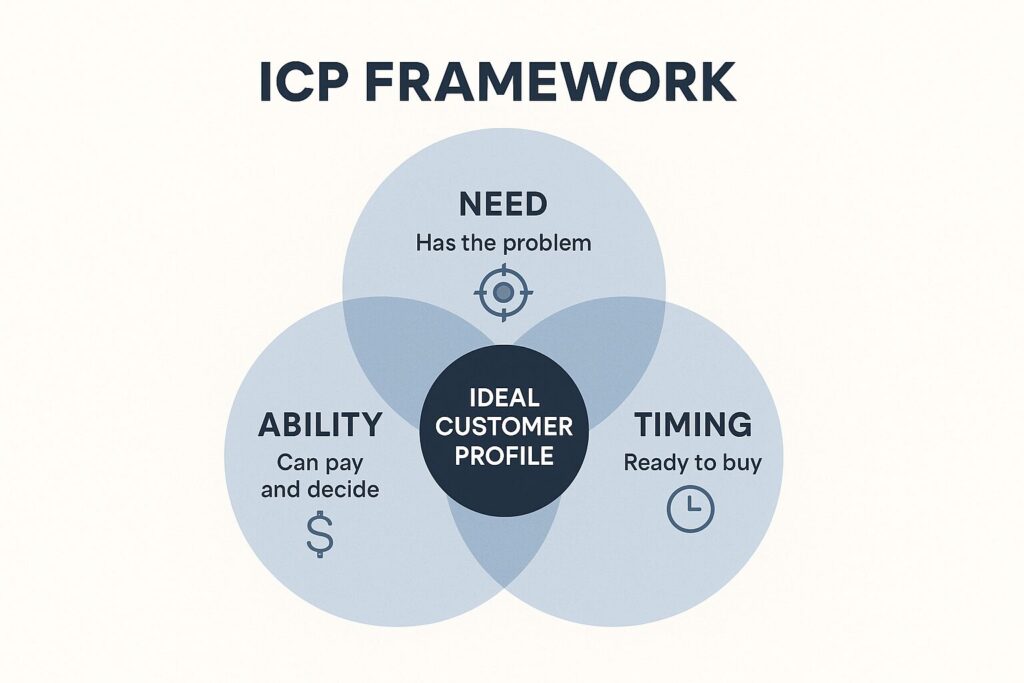
Here’s what I wish I’d learned from day one: an ideal customer profile goes beyond demographics, focusing on the intersection of need, ability, and timing.
Your B2B ICP should answer three core questions:
- Who has the problem you solve right now?
- Who has the resources and authority to buy your solution?
- Who is actively looking for or open to a solution like yours?
Think of it like dating. You don’t just want someone attractive (demographics). You want someone available, interested, and looking for the same kind of relationship you are. Your ideal customer profile is your “dating profile” for business.
Step 1: Define Your Firmographic Foundation
Start with the basics, but make them count. For B2B companies, this means:
Company Size: Not just “small business,” but get specific. Are we talking 10-50 employees? $1-5M in annual revenue? Companies with 2-10-person marketing teams?
Industry Verticals: Which industries have the highest concentration of your problem? Where do you see the most success stories?
Growth Stage: Are they startups burning through Series A funding, or established companies looking to optimize existing processes?
Geographic Focus: Sometimes location matters more than you think. Regulatory differences, cultural nuances, and even time zone alignment can impact your success rates.
A customer success platform refined its B2B Ideal Customer Profile using the following criteria:
| Attribute | Ideal Range | Series B to profitability |
|---|---|---|
| Company Size | 100-500 employees | Big enough to have customer success challenges, small enough to need external help |
| Revenue | $10M-$50M ARR | Can afford the investment, but is still growing rapidly |
| Industry | B2B SaaS, Professional Services | Industries where customer retention directly impacts revenue |
| Growth Stage | Series B to profitable | Have product-market fit, but scaling customer operations |
For B2C businesses, define your ideal customer by combining demographics with psychographics and buying behaviors. A fitness app’s ICP isn’t just “people who want to get in shape.” It might be “working professionals aged 28-45 who travel frequently, have household income over $75K, and have tried at least two other fitness solutions in the past year.“
Step 2: Layer in Psychographics and Behavioral Triggers
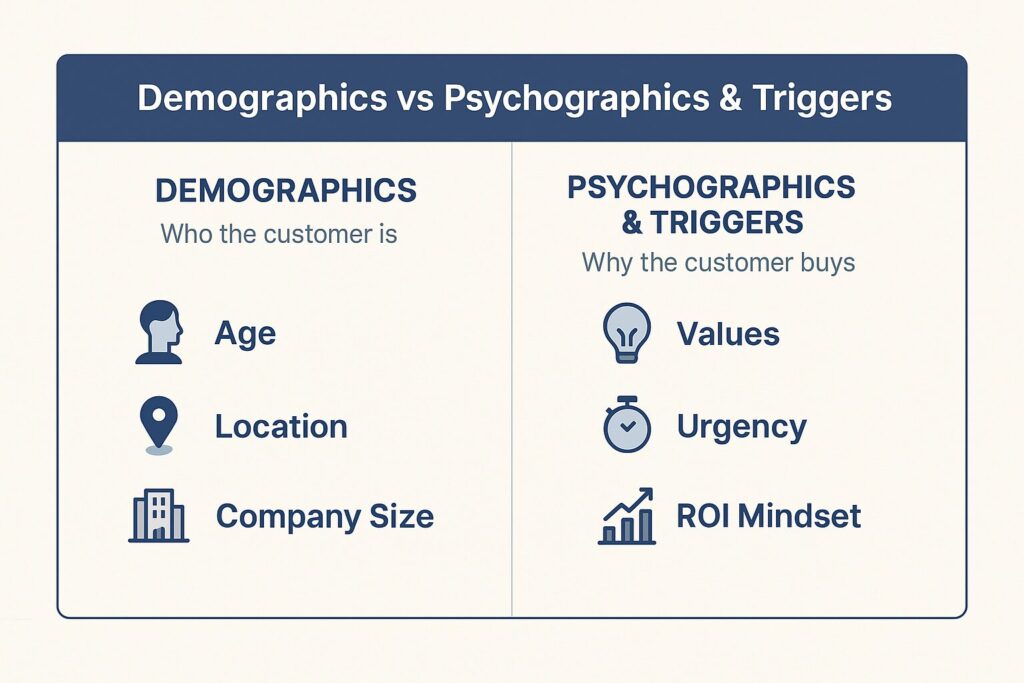
Layering in psychographics and behavioral triggers transforms your ICP from good to game-changing. Demographics tell you who your customer is, but psychographics reveal why they make a purchase.
Values and Priorities:
What do they care about most? Efficiency? Innovation? Cost savings? Status? Understanding their core values helps you communicate effectively with them.
Decision-Making Style:
Are they methodical researchers who want case studies and ROI calculations? Or are they quick decision-makers who trust their gut and value speed over perfection?
Pain Points and Frustrations:
What Keeps Them Up at 3 AM? What problems are they complaining about in industry forums and LinkedIn posts?
Behavioral Signals:
These are goldmine indicators that someone might be ready to buy:
- Recent funding announcements
- New leadership hires
- Product launches
- Expansion into new markets
- Regulatory changes affecting their industry
- Budget cycle timing
When I was at realtor.com, we discovered that our most valuable agent customers had one thing in common: they’d recently missed out on a significant listing opportunity in the past 12 months. That frustration made them far more receptive to tools and programs that could help them win the next one. That single insight reshaped how we prioritized outreach, content, and product positioning.
Step 3: Identify High-Value Problem Sets
Here’s where most B2B ICPs fall short: they concentrate on features rather than problems. Your ideal customer profile should revolve around the issues you solve better than anyone else. By focusing on these high-value problem sets, you can feel determined and focused on the most critical aspects of your ICP.
Ask yourself:
- What problems cost your ideal customer the most money?
- What challenges persist and worsen if left unaddressed?
- Where do your competitors consistently fall short?
Use this 3-part formula to define each problem set with precision:
1. Trigger Condition – A specific, observable situation or event that signals your ideal customer is experiencing the problem.
2. Pain Description – A clear articulation of what’s going wrong and why it matters to them.
3. Consequence of Inaction – What will happen if the problem persists, with a focus on cost, risk, or missed opportunity.
Formula Template: Companies/people who [Trigger Condition], where [Pain Description], and [Consequence of Inaction].
Example of how to use the 3-part formula
Instead of targeting “Companies that need project management.”
Breaking it down:
- Trigger Condition: “Growing companies where project delays are directly costing revenue”
- Pain Description: “teams are buried in status meetings”
- Consequence of Inaction: “leadership has zero visibility into project health until it’s too late”
Our ideal customers are growing companies where project delays directly cost revenue, teams are bogged down in status meetings, and leadership has limited visibility into project health until it’s too late.
Step 4: Source and Analyze Your Data
Now comes the fun part: turning your hypotheses into complex data. You want to look at this from multiple angles:
Internal Data Analysis:
- Pull your closed-won deals from the last 12-18 months
- Identify patterns in your best customers
- Look at customer lifetime value, time-to-close, and expansion revenue
- Interview your sales team: they know which prospects are easiest to convert
Customer Voice Research:
- Conduct win/loss interviews
- Survey your happiest customers about what drove their purchase decision
- Analyze support tickets to understand common pain points
- Listen to sales calls (with permission) to hear how prospects describe their challenges
External Market Research:
- Use tools like LinkedIn Sales Navigator to validate market size
- Check industry reports and trend data
- Analyze competitor customer bases
- Monitor relevant forums, communities, and social media discussions
One of my favorite tactics is the “reverse interview” approach. Instead of asking customers why they bought from you, ask them to describe their situation 12 months before becoming your customers. What broke? What prompted them to start seeking solutions? Having customers recount their situation a year before they made a purchase reveals invaluable insight into your ideal customer’s pre-purchase state.
Step 5: Build Your One-Page ICP Reference
All this research means nothing if your team can’t use it. Create a single-page ICP document that includes:
The Executive Summary: A 2-3 sentence description of your ideal customer that anyone can understand and remember.
Key Attributes Table: Demographics, firmographics, and behavioral indicators are presented in a clear and organized manner.
Problem Statement: The core challenges your ideal customer faces, written in their language.
Buying Triggers: Specific events or situations that make them actively look for solutions.
Red Flags: Equally significant are characteristics that indicate a prospect is not a good fit.
Your Ready-to-Use B2B Ideal Customer Profile Template:
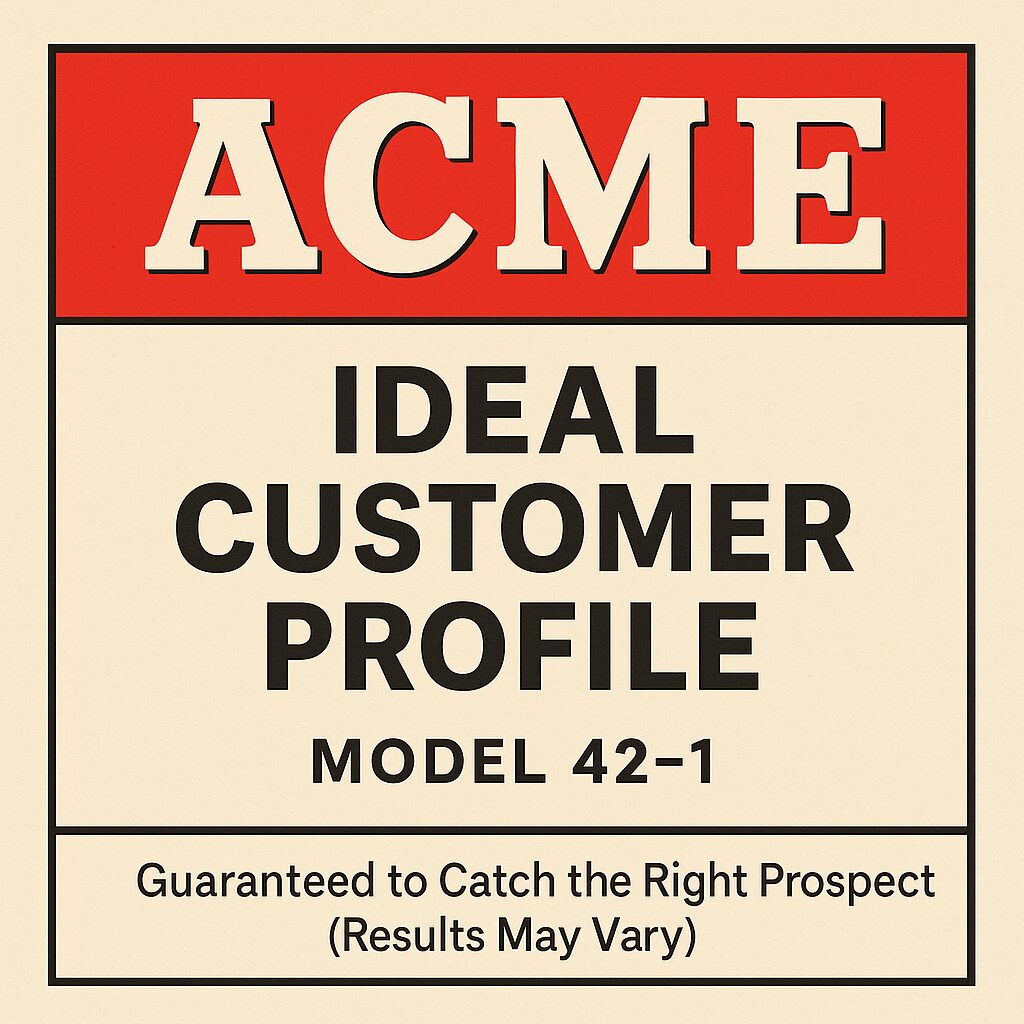
##
IDEAL CUSTOMER PROFILE: [ACME]
EXECUTIVE SUMMARY:
Growing B2B SaaS companies (Series A-B) with 50-200 employees who are struggling to scale their customer success operations and seeing increasing churn rates despite product improvements.
KEY ATTRIBUTES:
- Company Size: 50-200 employees
- Revenue: $5M-$25M ARR
- Industry: B2B SaaS, EdTech, FinTech
- Growth Stage: Series A to Series B
- Geography: North America, English-speaking markets
PAIN POINTS:
- Customers are churning faster despite product improvements
- Manual, reactive customer success processes
- Limited visibility into customer health and risk
- The customer success team is overwhelmed and reactive
BUYING TRIGGERS:
- Recent churn spike or considerable customer loss
- New Head of Customer Success hire
- Series B fundraising (expansion focus)
- Competitor customer success wins
RED FLAGS:
- Less than $2M ARR (too early)
- Enterprise sales cycles >18 months
- Highly regulated industries requiring custom compliance
- Companies with <10% churn (low urgency)
##
Step 6: Operationalize Your ICP
You’ve only fought half the battle once you’ve built the ICP. Now you need to get your entire go-to-market team singing from the same hymnal.
Sales Alignment:
Train your sales team to qualify prospects against ICP criteria as early as possible in the discovery process. Create talk tracks and discovery questions that help identify ideal vs. non-ideal prospects.
Marketing Alignment:
Use your ICP to inform everything from ad targeting to content topics. Your blog posts, case studies, and webinars should address your ideal customer’s specific challenges and goals directly.
Product Roadmap Influence:
Share ICP insights with your product team. Understanding your ideal customer’s workflow and pain points should influence feature prioritization.
Customer Success Integration:
Design your onboarding process, health scoring, and expansion strategies around the characteristics and needs of your ideal customer profile.
I recommend setting up quarterly ICP review sessions where sales, marketing, and customer success teams share insights and updates to ensure alignment and collaboration. Your ICP should be a living document that evolves with your business and market.
Common ICP Mistakes That Kill Growth
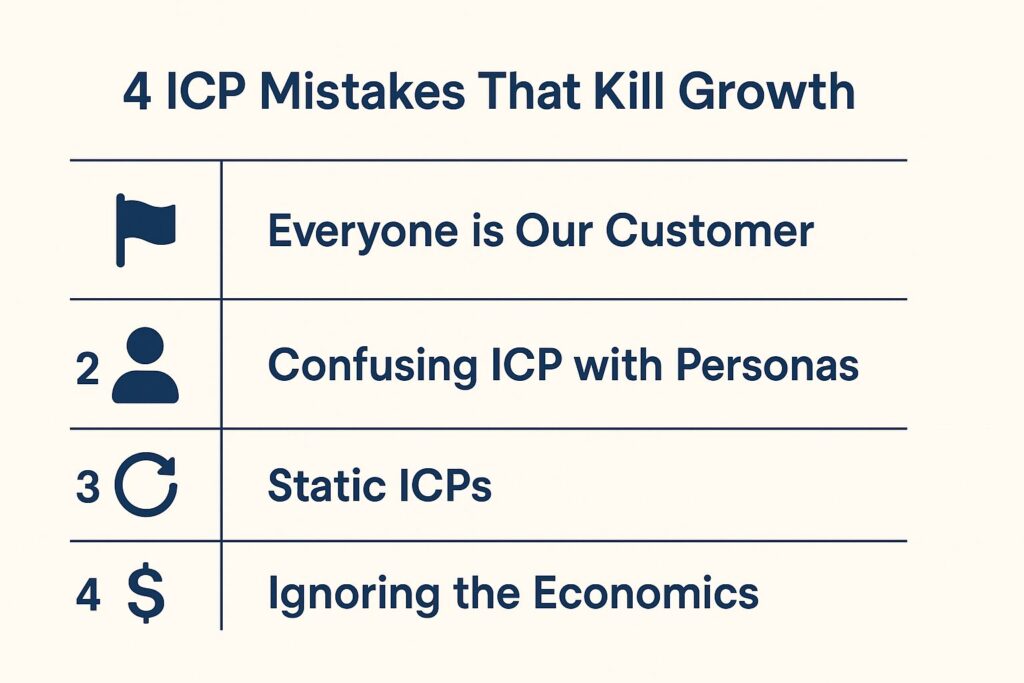
After helping dozens of companies refine their ideal customer profiles, I see the same mistakes over and over:
Mistake #1: The “Everyone is Our Customer” Syndrome.
If your ICP could describe 40% of businesses in your target market, it’s useless. Good ICPs exclude more people than they include.
Mistake #2: Confusing ICP with Buyer Personas.
Your ICP defines the company characteristics that make for ideal customers. Buyer personas represent the individual people within those companies who influence or make buying decisions. You need both, but they serve different purposes.
Put simply:
- ICP guides “who to target” – it informs lead qualification criteria, segmentation, and organizational alignment.
- Buyer persona guides “how to engage” – it drives messaging, content planning, and personalized outreach.
Mistake #3: Building Static ICPs.
Your ideal customer profile should evolve as your product, market, and competitive landscape change. Set calendar reminders to review and update your ICP every 6 to 12 months.
Mistake #4: Ignoring the Economics.
Not all “ideal” customers are profitable. Ensure your ICP considers customer acquisition cost, lifetime value, and time-to-close. Sometimes your “second-best” customer profile is more profitable to pursue.
Real-World ICP Success Story
When I was leading growth initiatives at Realtor.com, we noticed that our lead conversion rates had plateaued, despite a steady marketing spend. Our ICP at the time was basically “any real estate agent who wants more leads.” Broad, vague, and unhelpful.
After applying this ICP framework, we discovered our highest-value customers shared some particular traits:
- Mid- to top-producing agents closing 20–50 transactions annually
- Worked in competitive metro markets with high average transaction values
- Had an established team or at least one full-time assistant
- We’re already investing $50K+ per month in digital marketing
- We were frustrated with fragmented lead sources and wanted a single, trackable pipeline
This clarity completely shifted our go-to-market approach. Instead of targeting all agents, we repositioned to serve growth-minded, metro-based agents who were already investing heavily in lead generation but wanted better ROI and integrated tracking.
Results after 9 months:
- Lead-to-sale conversion rate increased from 1.2% to 2.8%
- Average deal size grew by 35% due to higher transaction values in target markets
- Customer lifetime value increased by 50%
- Churn dropped by 40% as we aligned with agents who valued our full-funnel capabilities
The breakthrough didn’t come from new ad campaigns – it came from identifying the agents who were already predisposed to love what we offered.
Your Next Steps: From Theory to Practice
Here’s your homework assignment (yes, I’m giving you homework):
- Start with your best customers: Pull data on your top 10-20 customers by lifetime value, expansion revenue, or advocacy. What patterns do you see?
- Interview 5 recent customers: Ask them about their situation before they found you, what triggered them to start looking for solutions, and what made them choose you over alternatives.
- Build your first draft ICP: Use the template I shared above. Don’t worry about making it perfect: make it worthwhile.
- Test and validate: Use your draft ICP to evaluate your current pipeline. How many of your prospects fit your ideal profile? What does that tell you about your current marketing and sales efforts?
- Get organizational buy-in: Share your ICP with sales, marketing, and customer success teams. Obtain their input and ensure that everyone understands how to use it.
The companies that are winning in today’s competitive landscape aren’t necessarily the ones with the best products or the most significant marketing budgets. They’re the ones who understand exactly who they’re trying to serve and have built everything around that clarity.
Your ideal customer profile isn’t just a marketing exercise: it’s your strategic foundation for sustainable growth. When you know exactly who you’re hunting, every decision becomes clearer. Every dollar gets spent more efficiently. Every conversation becomes more focused.
Stop trying to be everything to everyone. Start becoming the obvious choice for the right someone.
Other Great Resources for Mastering ICP Development
While this guide provides a solid foundation, I’m a firm believer in learning from multiple perspectives. Here are some other excellent resources that complement what we’ve covered:
A Few Of My Favorite Books That Go Deep:
- “Awesome” by April Dunford – Fantastic insights on positioning that directly inform ICP development
- “The Mom Test” by Rob Fitzpatrick – Essential reading for conducting customer interviews that reveal truth
- “Crossing the Chasm” by Geoffrey Moore – Classic framework for understanding customer segments in tech adoption
Tools for ICP Research:
- LinkedIn Sales Navigator – Unbeatable for B2B firmographic research and pattern identification
- Gong or Chorus – Call intelligence platforms that help you analyze what your best customers say during sales conversations
- Mixpanel or Amplitude – Product analytics tools that reveal behavioral patterns in your existing customer base
- Typeform or SurveyMonkey – For structured customer interviews and feedback collection
Communities and Learning:
- RevOps Co-op – Active community of revenue operations professionals sharing ICP best practices
- SaaStr Community – Tons of real-world ICP case studies from B2B SaaS leaders
- Marketing Ops Forum – Great discussions on operationalizing ICPs across marketing and sales teams
Industry Reports Worth Reading:
- Salesforce’s annual “State of Sales” report always includes data on targeting effectiveness
- HubSpot’s customer acquisition research provides benchmarks for ICP-driven growth
- McKinsey’s B2B customer decision journey studies offer an enterprise perspective on buying behavior
The key is not to get overwhelmed by all the available information. I recommend starting with the framework I’ve outlined here, then delving deeper into the specific areas where you require additional expertise.
Frequently Asked Questions About B2B Ideal Customer Profiles
How is an ICP different from a buyer persona?
Think of it this way: your ICP defines the company characteristics that make for ideal customers (company size, industry, growth stage). Buyer personas represent the individual people within those companies who influence or make buying decisions (job title, responsibilities, motivations). You need both, but they serve different purposes. Your ICP helps you identify which companies to target; your buyer personas help you craft messaging that resonates with decision-makers within those companies.
Should I have multiple ICPs or just one?
Most successful companies start with one primary ICP and nail that before expanding. However, if you serve distinctly different markets (like both B2B and B2C, or both startups and enterprise), you’ll likely need separate ICPs. The key is avoiding the temptation to create too many: I rarely see companies successfully execute against more than 2-3 distinct ICPs simultaneously.
How often should I update my ICP?
Plan for a formal B2B ICP review every 6-12 months, but remain vigilant for signals that suggest changes are needed sooner. Primary triggers for ICP updates include significant product pivots, entering new markets, shifts in the competitive landscape, or when you notice a drop in win rates with your current target profile. Your ICP should evolve with your business.
What if my best customers don’t fit a clear pattern?
This usually means you need to dig deeper into the data. Look beyond surface-level demographics to psychographics, behavioral triggers, and problem sets. Sometimes the pattern isn’t apparent until you examine the “why” behind their purchase decisions. If you can’t find patterns after thorough analysis, you might be in an early-stage market where customer profiles are still emerging.
Should my ICP include company size or revenue ranges?
Absolutely, but make them meaningful ranges based on your actual data, not arbitrary round numbers. A range like “100-500 employees” is more useful than “small to medium business.” The key is to ensure that your ranges align with your ability to create value and close deals efficiently.
How do I handle prospects who don’t fit my ICP but seem interested?
This is where judgment and experience come in. Have clear criteria for exceptions: they’re slightly outside your size range but in a high-value industry, or they’re missing one attribute but strong in others. Set a threshold (such as a 70% ICP match) and consistently adhere to it. Remember, every non-ideal customer you take on has an associated opportunity cost.
What’s the biggest mistake companies make with ICPs?
Making them too broad to be of any use. I’ve seen ICPs that describe half the market: that’s not targeting, that’s wishful thinking. A good ICP should exclude more prospects than it includes. If your sales team can’t quickly determine whether a prospect fits your ICP, it needs to be more specific.
How do I get buy-in from leadership that wants to “keep options open”?
Show them the math. Calculate the cost of unfocused targeting, including longer sales cycles, lower win rates, higher churn, and increased customer acquisition costs. Frame ICP development as risk mitigation, not opportunity limitation. You’re not saying you’ll never serve other customers; you’re saying you’ll prioritize resources on the highest-probability opportunities first.
Can I use AI or machine learning to build my ICP?
AI can assist with data analysis and pattern recognition, particularly when you have an extensive customer database. Tools like Clay, Apollo, or even custom ChatGPT analysis can surface insights you might miss manually. However, don’t let technology replace the qualitative insights you get from actually talking to customers. The best ICPs combine data science with human understanding.
Ready to build your own high-converting ICP? I’ve created a FREE Notion ICP template and worksheet that walks you through each step of this process. Download it and start identifying your ideal customers today.
Want more frameworks for operational excellence? Subscribe to our newsletter for weekly insights on AI, operations, and growth strategy that move the needle. And if you’re ready to take your go-to-market strategy to the next level, let’s connect on LinkedIn – I love nerding out about customer research with fellow operators.
Related Articles
The Best B2B vs B2C Testing Strategies for 2025
The Ultimate B2C Growth Metrics Guide to Explode Your Revenue
B2C Brand Health Metrics Guide: Unlock Growth Now
How to Create a Winning Data-Driven Sales Strategy
Proven B2B Outreach Strategy That Gets Real Results
B2B Metric Frameworks Infographics: Unlock Growth & Profits Now
About the Author
I write about:
- AI + MarTech Automation
- AI Strategy
- COO Ops & Systems
- Growth Strategy (B2B & B2C)
- Infographic
- Leadership & Team Building
- My Case Studies
- Personal Journey
- Revenue Operations (RevOps)
- Sales Strategy
- SEO & Digital Marketing
- Strategic Thinking
📩 Want 1:1 strategic support?
🔗 Connect with me on LinkedIn
📬 Read my playbooks on Substack
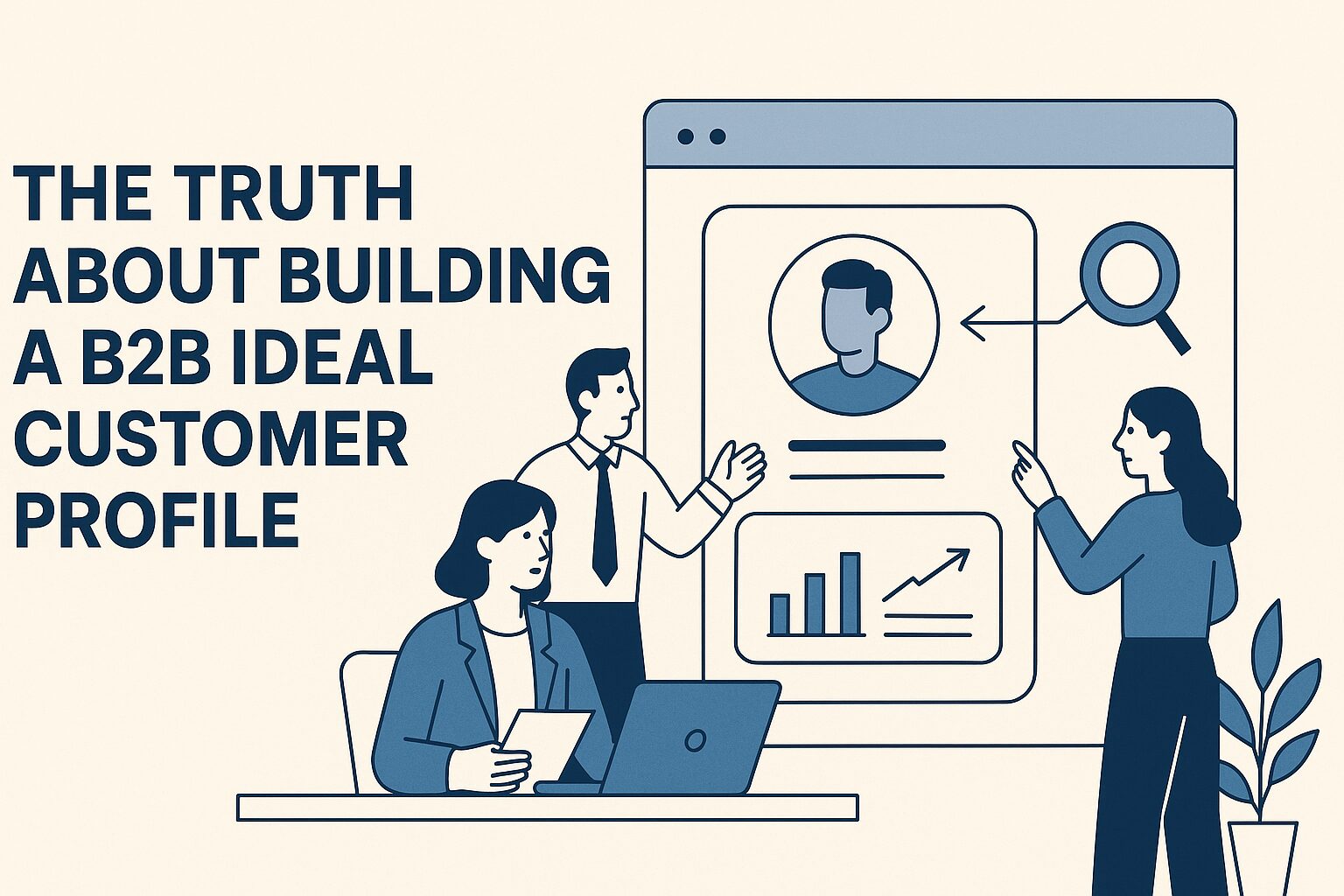
Leave a Reply